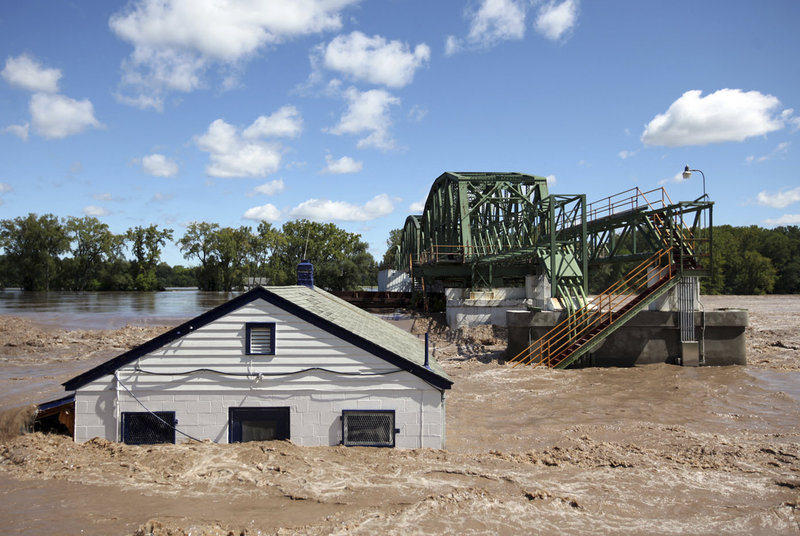MONTPELIER, Vt. — The full measure of Hurricane Irene’s fury came into focus Monday as the death toll jumped to 38, New England towns battled epic floods and millions faced the dispiriting prospect of several days without electricity.
From North Carolina to Maine, communities cleaned up and took stock of the uneven and hard-to-predict costs of a storm that spared the nation’s biggest city a nightmare scenario, only to deliver a historic wallop to towns well inland.
In New York City, where people had braced for a disaster-movie scene of water swirling around skyscrapers, the subways and buses were running again in time for the Monday morning commute. And to the surprise of many New Yorkers, things went pretty smoothly.
But in New England, Vermont contended with what its governor called the worst flooding in a century after Irene dumped up to 11 inches of rain, washing out roads and bridges, cutting off about a dozen towns, leaving thousands of homes and businesses without power and killing at least three people.
President Obama signed an emergency declaration, making federal assistance available for the state.
Waterbury was among the hardest-hit communities as floodwaters shut down the Vermont Emergency Management headquarters, the Vermont State Hospital and other state agency offices. About 50 patients were moved from the psychiatric hospital to other facilities.
“It breaks your heart to see the extraordinary devastation that we’re seeing here in Vermont,” Gov. Peter Shumlin said after touring the state by helicopter with U.S. Sen. Patrick Leahy, D-Vt., and others. “I do not believe that we have seen flooding like this in our state’s history.”
State emergency workers had to evacuate Monday in the middle of trying to manage the disaster. They moved to Federal Emergency Management Agency offices in Burlington.
Signs of Sunday’s storm – a mud-caked Main Street, an inundated ball field and flooded-out homes – were visible throughout Waterbury.
“It’s a mess, a total disaster,” 42-year-old Justine Barup said, her voice breaking, as she surveyed her front yard covered in silt and mud.
Elsewhere, a ski lodge partially collapsed at the Killington resort in south-central Vermont. No one was in the lodge at the time, but about 300 guests at a resort hotel and condominiums – as well as 100 Killington resort staff – were stranded because the roads were washed out, said Killington marketing manager Chris Danforth.
The deaths included a young woman from Macedonia participating in a work program at southern Vermont’s Mount Snow resort. She was swept away while watching the Deerfield River on Sunday.
The governor said a man died in Ludlow, though no additional details were available.
A Rutland city worker, checking on the city’s water supply in neighboring Mendon, apparently fell into Mendon Brook when its bank collapsed. Michael Joseph Garofano, 55, was later confirmed dead. His son, Michael G. Garofano, 24, who was with him at the time, was missing.
Shumlin and Leahy defended the state’s decision not to order more extensive evacuations before the storm arrived, saying it would have been impossible to predict which towns would be hardest-hit.
“What are you going to do, evacuate the entire state of Vermont?” Shumlin asked.
Streams also raged out of control in upstate New York, where Irene dumped up to 13 inches of rain. “We were expecting heavy rains,” said Bobbi-Jean Jeun of Clarksville, a hamlet near Albany, N.Y. “We were expecting flooding. We weren’t expecting devastation.”
For many, the aftermath could prove more painful than the storm itself.
In North Carolina, where Irene blew ashore along the Outer Banks on Saturday, 1,000 people were still in emergency shelters, awaiting word on their homes.
Nearly 5 million homes and businesses in a dozen states were still without electricity, and utilities warned it might be a week or more before some people get their power back.
Up and down the Eastern Seaboard, commuters and vacationers found their travel plans scrambled. Airlines warned it would be days before the thousands of passengers stranded by Irene find their way home. Some Amtrak service in the Northeast was suspended.
Early estimates put Irene’s damage at $7 billion to $10 billion; in comparison, Hurricane Katrina did more than $100 billion in damage.
Send questions/comments to the editors.



Success. Please wait for the page to reload. If the page does not reload within 5 seconds, please refresh the page.
Enter your email and password to access comments.
Hi, to comment on stories you must . This profile is in addition to your subscription and website login.
Already have a commenting profile? .
Invalid username/password.
Please check your email to confirm and complete your registration.
Only subscribers are eligible to post comments. Please subscribe or login first for digital access. Here’s why.
Use the form below to reset your password. When you've submitted your account email, we will send an email with a reset code.